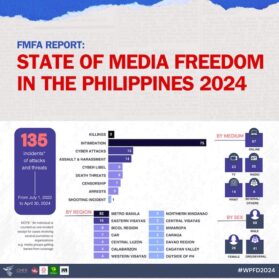GENERAL SANTOS CITY (MindaNews/08 August) – South Cotabato officials are planning to regulate the fish cage operations at the scenic Lake Sebu in the wake of the tilapia fish kill last month that left a damage of P1.04 million.
South Cotabato Gov. Arthur Pingoy Jr. said Monday he directed the local government’s environment and agriculture offices to conduct a comprehensive study on the status of the fish cage operations and formulate regulatory policies that would help properly manage Lake Sebu’s fishery resources.
He said the move is mainly aimed at preventing a potential massive fish kill, which has already become an annual occurrence that locals call “kamahong”, a phenomenon marked by a rise in the water temperature.
A report from the Office of the Provincial Agriculturist noted that the fish kill last July 24 to 26 at the 354-hectare Lake Sebu devastated some 13 metric tons of tilapia.
It affected 56 fish cages of seven major operators situated in Sitios Isla Grande, Lot 70, Bakikot and TukoFol of Poblacion, Lake Sebu.
Citing accounts by Lake Sebu residents, Pingoy said the fish kill occurred even before the fish cages were set up at the 354-hectare lake.
But he said the “kamahong” phenomenon, which triggered the rise of sulfuric acid in the lake’s waters, appeared to have worsened in the past several years due to the mushrooming of fish cages along the lake.
“Studies showed that the fish kill was mainly caused by the overcrowding of the fish cages at the lake and too much use of commercial fish feeds. We might need to regulate the presence of the
fish cages to save the lake from further degradation,” the governor said.
Rex Vargas, fishery coordinator of the Office of the Provincial Agriculturist, said the tilapia fish kill usually occurs during the months of June to February every year.
“It occurs when cold rain water, which is heavier than warm water, settles at the abyssal zone of the lake. This causes the water upturn or updwelling of warm water, carrying silts, sediments, and gases such as hydrogen sulfide, ammonia, sulphur and methane gas produced by the decomposing organic matter such as fish feeds,” he explained.
He said such situation results in the reduction of dissolved oxygen in the water, “forcing fishes to take in oxygen directly from the atmosphere and eventually die.”
To help offset the recent impact of the fish kill Pingoy said they are set to acquire some 500,000 tilapia fingerlings to help replenish the lake’s devastated fish stocks.
He said the Department of Agriculture, through the Bureau of Fisheries and Aquatic Resources (BFAR)- Region 12, has committed to provide up to one million tilapia fingerlings for Lake Sebu.
“The fingerlings will not be given to the affected fish cage operators but will be dispersed at the lake,” Pingoy said.
Vargas said they sought assistance from BFAR regarding the problem in a meeting last week with BFAR representatives, municipal fishery coordinators and fishery aquatic council chairs from General Santos City and Panabo, Davao del Norte.
He said the local government will acquire the tilapia fingerlings at a discounted rate of 25 centavos each. (Allen V. Estabillo/MindaNews)
